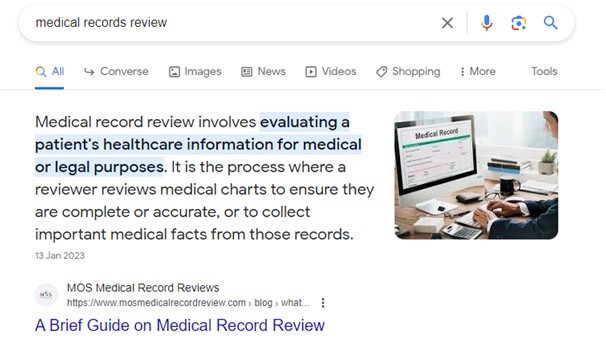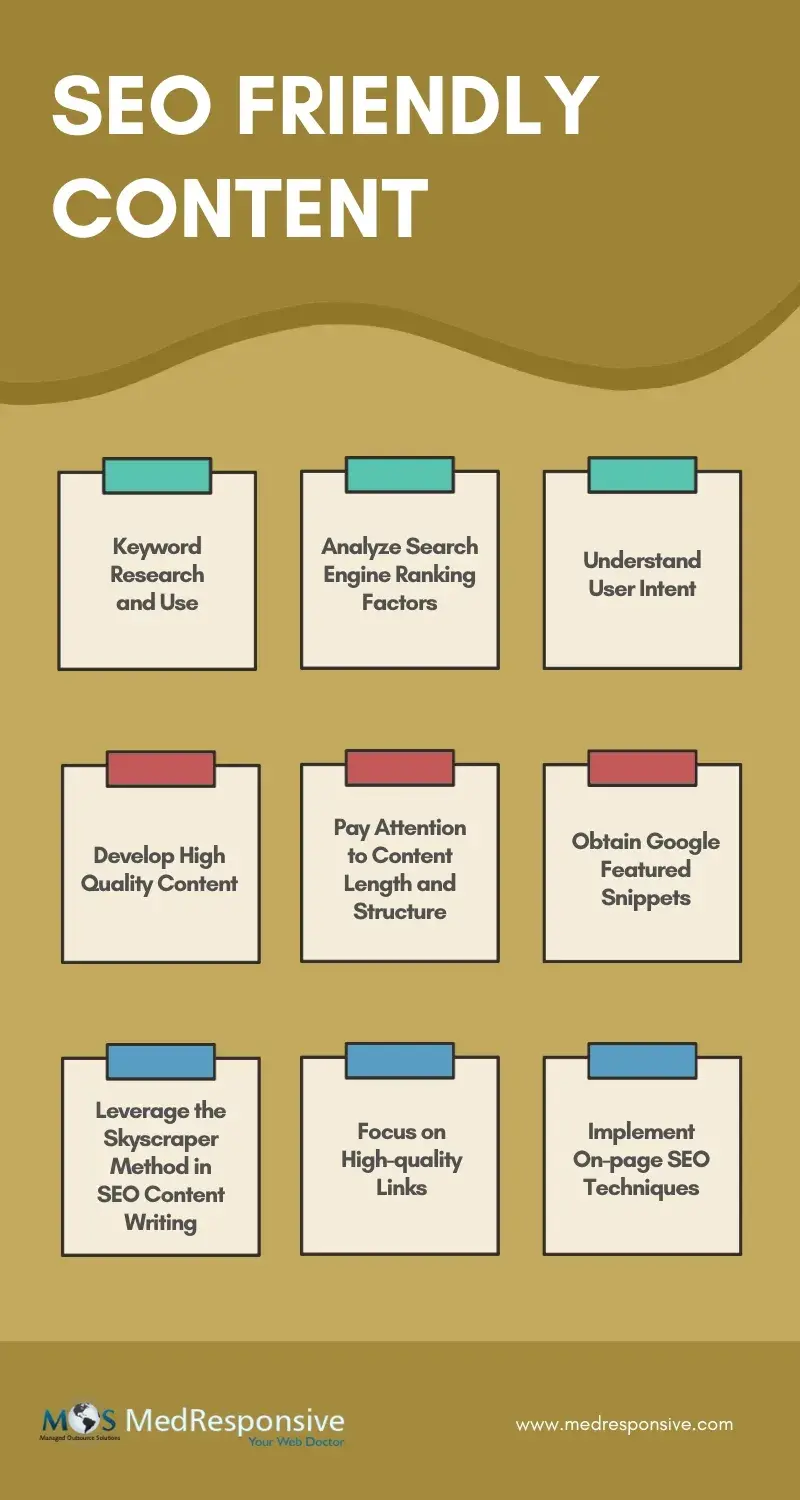In today’s content marketplace, publishing SEO-rich content is crucial to reach your target audience and achieve better search rankings. Be it medical SEO, eCommerce SEO or SEO for other business sectors, both quality and quantity of content are crucial to improve online visibility. To publish top quality content that appeals to the users and Google’s algorithms, digital marketers and content writers need to analyze the search engine ranking factors, conduct a comprehensive keyword research based on searcher intent, and focus on the right keywords that are relevant to their specific audience group. Investing in content writing services provided by digital marketing experts can help you publish quality content and boost your online presence.
Relevance of Writing SEO-friendly Content
When devising a strategy to drive organic traffic to your website, remember that content writing and SEO go hand in hand. High-quality, relevant, and engaging content not only attracts organic traffic but also satisfies user intent, which search engines prioritize. Content optimization, including keyword usage, readability, and multimedia elements, is vital for effective SEO.
SEO-friendly content means creating content that search engines can understand. Writing content that includes specific keywords related to your products/services will make your website visible to search engine algorithms. Search engine robots crawling, indexing, and ranking the website will recognize these signals and elevate the site’s position in the SERPs (Search Engine Results Pages). Developing content that is better than the competition, and optimizing it with both on-page and off-page SEO techniques will help your business stand out.
Effective websites often utilize a combination of content types to provide a well-rounded and engaging user experience.
Here, we focus on text content, which generally includes:
- Articles and blog posts: Informative and engaging written pieces on various topics.
- Product descriptions: Detailed descriptions of products or services offered.
- About us: Information about the company, team, and mission.
- FAQs: Frequently asked questions and answers for visitors.
- Testimonials: Reviews and feedback from customers or clients.
- News updates: Latest news, press releases, or announcements.
9 Tips to Ensure Your Content is SEO-friendly
Although there is no secret formula for writing high-quality content, following these tips can go a long way in ensuring that your content is SEO-friendly:
- Keyword Research and Use – Start by identifying relevant keywords and phrases related to your content. Use keyword research tools to find popular and high search volume keywords or terms that are relevant to your website’s topic. To select the most appropriate keywords, determine which topics searchers are interested in, trace the search volumes for topics, and understand how difficult it may be to rank for a topic.
- Analyze Search Engine Ranking Factors – Understanding search engine ranking factors is vital. The primary four are content, links, site structure, and HTML tags, with content as Google’s top priority. Creating comprehensive, valuable content is key. Factors like quality, authority, keywords, freshness, and multimedia use impact content ranking. Correctly using these is crucial for competitive content. Non-content elements such as inbound/outbound links, URL structure, page speed, and keyword usage also affect rankings. Adhere to best practices for linking, site structure, and HTML while developing content will aid search engine crawling and indexing.
- Understand User Intent – SEO involves much more than using the right keywords. Perform comprehensive research on the target audience groups to understand main search queries used, why people are searching with those specific keywords and what competitors are offering. Identify what the searcher is looking for when they type the query into a search bar, and then cover the topic in a way that directly meets their needs. This is an important aspect of content optimization. According to Google’s search evaluation quality guidelines, there are four categories of search intent:
- Know – Theuser is seeking information or answers to specific questions.
- Do – The userintends to complete a specific action or task (for e.g., making a purchase, signing up for a newsletter, or downloading a file).
- Website – The user wants to find a specific website or web page.
- Visit-in-person – The user is interested in finding a physical location or a nearby place to visit.
- Develop High Quality Content – Create high-quality, engaging content that adds value. Use keywords naturally and address your audience’s needs. Each piece should target a unique primary keyword and include related LSI keywords. For blog posts, opt for low-competition, long-tail keywords for better conversion rates. For pillar pages, prioritize high-volume, competitive seed keywords.
- Pay Attention to Content Length and Structure – To grab search engines’ attention, aim for ideal content length and keywords. Headings, bullet points, and header tags are vital for signaling website quality. Structure content with headers (H1, H2, H3, etc.) for clarity. Embed keywords in headings to enhance search context.
- Obtain Google Featured Snippets – “Featured Snippets,” the concise text displayed on top Google search results, immediately address user queries. Extracted from web pages in Google’s index repository, these snippets come in various forms like lists, tables, steps, and definitions. Utilize factual information and address several “People also ask” queries within your content to enhance visibility.
To get your content to feature in the highest position on SERPs, focus on the following –
-
- Check if a snippet already exists for your keywords. Use tools like SEMrush for this purpose.
- Understand its structure — whether it is a paragraph, list, or a table.
- Include a subheading in the content with a question and provide a more valuable, concise answer that addresses the problem. The response should be better than the featured snippet in all aspects.
Do you know why featured snippets are important, especially for SEO? Let’s check it out in detail.
What Is a Featured Snippet? How to Optimize for Google’s Featured Snippets
- Leverage the Skyscraper Method in SEO Content Writing – Use the Skyscraper Technique for high-quality content. Start by identifying popular content in your niche, relevant to your keywords. Then create superior, well-researched material with visuals, data, and SEO optimization. Reach out to influencers and sites linking to similar content, promoting yours. Track results with tools like Ahrefs or SEMrush. This method boosts rankings and traffic but demands substantial time and outreach effort.
- Focus on High-quality Links – Linking to credible sites adds significant value. Target authoritative, relevant websites for outbound links in blog posts and pillar pages. Seek backlinks from topic authorities; they heavily influence Google rankings.
- Implement On-page SEO Techniques – Understanding on-page SEO is vital for optimal search results. HTML tags are among the first elements scanned by search engines. Embed the target keyword within the initial 100 words of your content. Google now considers ‘User Signals,’ including bounce rate and organic click-through rate. Correctly utilize target and LSI keywords in titles, meta descriptions, headings, and the initial content segment.
When creating quality content, optimizing site structure and technical SEO is also vital for ranking. Factors like page load speed, security, and crawlability directly affect indexing and ranking. Search engines now favor a topic cluster-driven structure, linking blog posts targeting specific keywords to comprehensive pillar pages. Poor site structure and technical errors hinder content ranking despite its quality. Prioritize a mobile-friendly, responsive website for higher search engine rankings due to increased mobile usage.
Leveraging content creation services are an ideal way to create high-quality written materials for your website, blogs, social media, and other digital platforms. These services can handle a wide range of content types, including articles, blog posts, product descriptions, SEO-optimized content, marketing copy, press releases, and more. By ensuring quality content for your business, experts can help you enhance search engine visibility, attract and retain customers, and establish authority in your industry.







